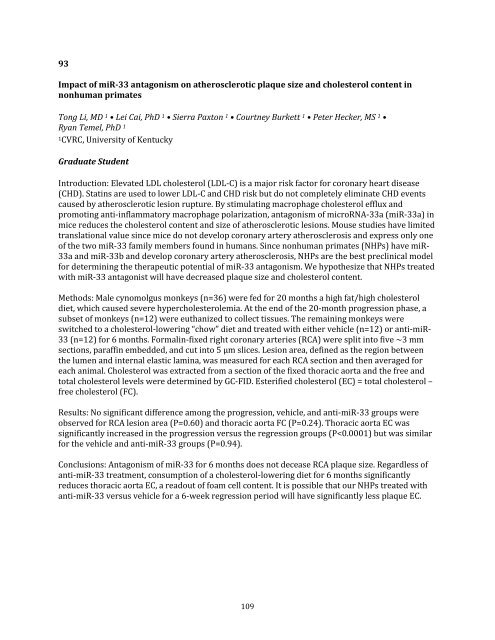2017 Cardiovascular Research Day Abstract Book
You also want an ePaper? Increase the reach of your titles
YUMPU automatically turns print PDFs into web optimized ePapers that Google loves.
93<br />
Impact of miR-33 antagonism on atherosclerotic plaque size and cholesterol content in<br />
nonhuman primates<br />
Tong Li, MD 1 • Lei Cai, PhD 1 • Sierra Paxton 1 • Courtney Burkett 1 • Peter Hecker, MS 1 •<br />
Ryan Temel, PhD 1<br />
1CVRC, University of Kentucky<br />
Graduate Student<br />
Introduction: Elevated LDL cholesterol (LDL-C) is a major risk factor for coronary heart disease<br />
(CHD). Statins are used to lower LDL-C and CHD risk but do not completely eliminate CHD events<br />
caused by atherosclerotic lesion rupture. By stimulating macrophage cholesterol efflux and<br />
promoting anti-inflammatory macrophage polarization, antagonism of microRNA-33a (miR-33a) in<br />
mice reduces the cholesterol content and size of atherosclerotic lesions. Mouse studies have limited<br />
translational value since mice do not develop coronary artery atherosclerosis and express only one<br />
of the two miR-33 family members found in humans. Since nonhuman primates (NHPs) have miR-<br />
33a and miR-33b and develop coronary artery atherosclerosis, NHPs are the best preclinical model<br />
for determining the therapeutic potential of miR-33 antagonism. We hypothesize that NHPs treated<br />
with miR-33 antagonist will have decreased plaque size and cholesterol content.<br />
Methods: Male cynomolgus monkeys (n=36) were fed for 20 months a high fat/high cholesterol<br />
diet, which caused severe hypercholesterolemia. At the end of the 20-month progression phase, a<br />
subset of monkeys (n=12) were euthanized to collect tissues. The remaining monkeys were<br />
switched to a cholesterol-lowering “chow” diet and treated with either vehicle (n=12) or anti-miR-<br />
33 (n=12) for 6 months. Formalin-fixed right coronary arteries (RCA) were split into five ~3 mm<br />
sections, paraffin embedded, and cut into 5 µm slices. Lesion area, defined as the region between<br />
the lumen and internal elastic lamina, was measured for each RCA section and then averaged for<br />
each animal. Cholesterol was extracted from a section of the fixed thoracic aorta and the free and<br />
total cholesterol levels were determined by GC-FID. Esterified cholesterol (EC) = total cholesterol –<br />
free cholesterol (FC).<br />
Results: No significant difference among the progression, vehicle, and anti-miR-33 groups were<br />
observed for RCA lesion area (P=0.60) and thoracic aorta FC (P=0.24). Thoracic aorta EC was<br />
significantly increased in the progression versus the regression groups (P


